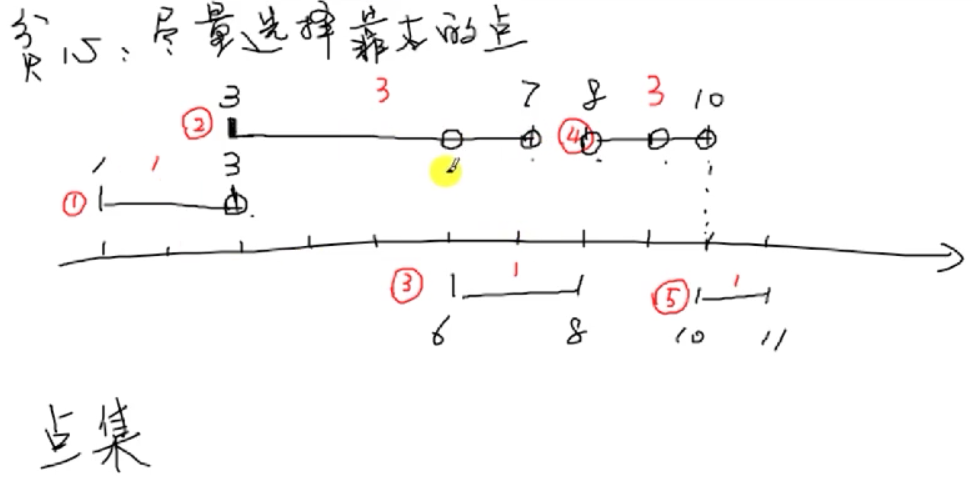// 数轴上有n个闭区间[ai,bi]。取尽量少的点,使得每个区间内都至少有一个点(不同区间内含的点可以是同一个)。
/*
Intervals
You are given n closed, integer intervals [ai, bi] and n integers c1, ..., cn.
Write a program that:
reads the number of intervals, their end points and integers c1, ..., cn from the standard input,
computes the minimal size of a set Z of integers which has at least ci common elements with interval [ai, bi], for each i=1,2,...,n,
writes the answer to the standard output.
Input
The first line of the input contains an integer n (1 <= n <= 50000) -- the number of intervals.
The following n lines describe the intervals. The (i+1)-th line of the input contains three integers ai,
bi and ci separated by single spaces and such that 0 <= ai <= bi <= 50000 and 1 <= ci <= bi - ai+1.
Output
The output contains exactly one integer equal to the minimal size of set Z
sharing at least ci elements with interval [ai, bi], for each i=1,2,...,n.
Sample Input
5
3 7 3
8 10 3
6 8 1
1 3 1
10 11 1
Sample Output
6
*/
//POJ1201

思路:
每次先选单个区间最后一个点,这样更容易包含其它区间,取尽量少的点
1 import java.util.Arrays; 2 import java.util.Scanner; 3 4 public class Eight_5贪心策略例题_区间选点问题 { 5 private static class Interval implements Comparable<Interval>{ 6 int s; 7 int t; 8 int c; 9 10 public Interval(int s, int t, int c) { 11 this.s = s; 12 this.t = t; 13 this.c = c; 14 } 15 16 @Override 17 public int compareTo(Interval other) { 18 int x = this.t - other.t; 19 if(x == 0) 20 return this.s - other.s; 21 else 22 return x; 23 } 24 } 25 26 /** 27 * 统计axis上s-t区间已经有多少个点被选中 28 */ 29 private static int sum(int[] axis, int s, int t){ 30 int sum = 0; 31 for(int i = s; i <= t; i++){ 32 sum += axis[i]; 33 } 34 return sum; 35 } 36 public static void main(String[] args) { 37 Scanner in = new Scanner(System.in); 38 int n = in.nextInt(); 39 Interval[] intervals = new Interval[n]; 40 for(int i = 0; i < n; i++){ 41 intervals[i] = new Interval(in.nextInt(), in.nextInt(), in.nextInt()); 42 } 43 Arrays.sort(intervals); //按区间右端点排序 44 45 int max = intervals[n-1].t; //右端最大值 46 int[] axis = new int[max+1]; //标记数轴上的点是否已经被选中 47 //int[] sums = new int[max+1]; 48 for(int i = 0; i < n; i++){ 49 //1.查阅区间中有多少个点 50 int s = intervals[i].s; //起点 51 int t = intervals[i].t; //终点 52 int cnt = sum(axis, s, t); //找到这个区间已经选点的数量,sum[t]-sum[s-1];低效率 53 54 //2.如果不够,从区间右端开始标记,遇标记过的就跳过 55 intervals[i].c -= cnt; //需要新增的点的数量 56 while(intervals[i].c > 0){ 57 if(axis[t] == 0){ //从区间终点开始选点 58 axis[t] = 1; 59 intervals[i].c--; //进一步减少需要新增的数量 60 t--; 61 }else{ //如果这个点已经被选过了 62 t--; 63 } 64 } 65 } 66 System.out.println(sum(axis, 0, max)); 67 } 68 }